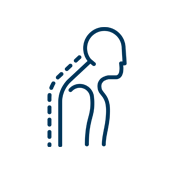31 Mar Importance of Good Posture
In case you missed our last newsletter our very own Dr. Martin Mamo did a great post on the importance of good posture!

One of the most common things we get asked to assess in the clinic is posture. What is the ideal posture? Well, the ideal posture is basically when little muscular energy is required to be exerted in order to maintain an upright position. This is obviously dependent on the type of activity you may be doing, for example, the ideal sitting posture is different to the ideal standing posture.
The above diagram shows the ideal standing posture through to poor posture. Posture is measured by a plumb line that starts at the ear and passes through the shoulder, just forward of the hip and the ankle. At this position theoretically, we should be exerting the least amount of energy while we stand. This is not the case though for the majority of our population, as quite often our jobs and recreational activities play a role in having an effect in being able to achieve the ideal posture.
Due to these outside influences, our body has a remarkable ability to compensate and adapt to try and maintain a posture that requires a minimal amount of energy to be exerted. There is a limit however on how much each individual’s body can cope with when exposed to less efficient postures, thus leading to joint sprains, ligament strains or tendinopathies.
Our role as the osteopath is to try and balance out the muscles working harder due to having to compensate and to strengthen the weakened muscle to help achieve the ideal posture.
The following are tips on how to maintain posture when sitting, standing, or lying
How to sit correctly
• Keep your feet on the floor, or on a footrest if they don’t reach the floor.
• Don’t cross your legs. Your ankles should be in front of your knees.
• Keep a small gap between the back of your knees and the front of your seat.
• Your knees should be at or below the level of your hips.
• Adjust the backrest of your chair to support your low- and mid-back or use a back support.
• Relax your shoulders and keep your forearms parallel to the ground.
• Avoid sitting in the same position for long periods of time.
How to stand correctly
• Bear your weight primarily on the balls of your feet.
• Keep your knees slightly bent.
• Keep your feet about shoulder-width apart.
• Let your arms hang naturally down the sides of the body.
• Stand straight and tall with your shoulders pulled backward.
• Tuck your stomach in.
• Keep your head level-your earlobes should be in line with your shoulders. Do not push your head forward, backward, or to the side.
• Shift your weight from your toes to your heels, or one foot to the other, if you have to stand for a long time.
How to sleep correctly
• Sleep with a pillow.
• Avoid sleeping on your stomach.
• Sleeping on your side or back is more often helpful for back pain.
• If you sleep on your side, place a pillow between your legs.
• If you sleep on your back, keep a pillow under your knees.
If you are finding you’re having back pain symptoms and problems or need some help with your posture please contact us at Complete Health Care Sunbury.
By Martin Mamo.


